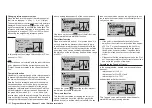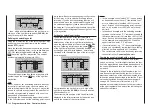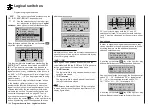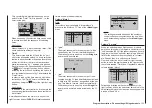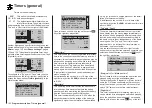
156 Program description - Phase settings | Helicopter models
This option is available as standard on
both transmitter types.
Use the selection keys of the left or right
four-way button to scroll to the »Phase
settings« menu option in the Multi-function menu:
Phase settings
Phase assignment
Logical switch
Timers (general)
Non-delayed chan
Fl. phase timers
Open this menu option with a tap on the center
SET
key of the right four-way button.
Auto
Pha1
Pha2
Name
ph.Tim.
Pha3 –
–
–
–
Pha4
Autorot
Within one model memory, the transmitters
mc-16
HoTT and
mc-20
HoTT lets you program up to 6
discrete groups of settings for various conditions met
during the flight. These are in addition to the auto-
rotation flight phase that can be set up in the »Basic
settings, model« menu. The grouped settings are
typically termed “flight phases” and are programmed
in appropriate menus.
Setting up flight phases
When you set up flight phases for helicopter models,
you start with this menu. You assign individual phases
a name and also assign a period of time for a (soft)
transition into each phase. Note that – depending on
your model and your settings – switch times much
longer than the default 0.1 s have proven useful. You
can also set up several phases with names and tran-
sition times even if you don’t currently have a use for
Phase settings
Setting up flight phases
them, since the decision as to which of the “occupied”
phases you activate is made only on the »Phase as-
signment« menu, page 158, when setting “phase
switches”.
The “Status” column, second from the left, shows
which one of the phases 1 … 6, including the autoro-
tation phase this is 7, has already been assigned to a
switch, plus the current status of that switch:
Symbol
Meaning
–
No switch assigned
+
Phase can be accessed via switch
Indicates the phase currently active
Note:
The “Copy flight phase” option on the »Copy / Erase«
menu is a useful aid when programming the vari-
ous flight phases. First, you need to determine the
parameters for a specific flight phase; these are then
copied to the next flight phase, where they can then
be modified as appropriate.
Column “Name”
The first line, and thus the first flight phase, is re-
served for autorotation flight, see »Basic settings,
model« menu. Accordingly, the predefined name
cannot be changed.
Use the selection keys to move to the line “Phase 1”.
Briefly tap on the center
SET
key of the right four-way
button then assign the needed phase (phase 1 up
to maximum of 6 phases) by picking the respective
name from the selection list with the selection keys of
the left or right four-way button.
The order in which phases 1 to max. 6 are assigned
is entirely irrelevant and you can leave gaps as you
wish. Nonetheless, you should always start with
“Phase 1”, the “Normal phase”, which is always active
if …
• … no phase switch is set in the »Phase assign-
ment« menu or if
• no phase has been assigned to specific combina-
tions of switches.
The definition of the phase name “Normal” could
therefore be a useful one to adopt for “Phase 1”.
The names themselves have absolutely no technical
significance for programming; their only purpose is to
help you to identify which phase is active at any time
and are thus displayed in all flight phase-dependent
menus and also on the transmitter’s basic display.
Column “ph. Tim.”
In addition to the standard timers on the basic screen
display, other timers are also available whose settings
are configured in the »Flight phase timers« menu,
page 166.
Clk 1, Clk 2, Clk 3, Lap, Time1, Time2
The flight phase timers “Clk 1 … 3” plus “Time1” and
“Time2” run only in the flight phase to which they
have been assigned in this menu. During other flight
phases they are stopped (and hidden) and the as-
signed stop/start switch then has no effect.
The lap counter, once started, continues to run
through changes of phase, however, although it can
be stopped during any flight phase via the center
ESC
key of the left four-way button.
While you can obviously record lap times using “Lap”
and a switch, the two timers “Time1” and “Time2”
have the following meaning:
• Time1
This timer will only measure time during which the
switch or control switch assigned in the “Lap time/
Tim tab” line of the »Flight phase timers« menu,
page 166, is “closed”. The frequency at which the
switch is activated is shown on the basic display.
This counter field is highlighted as soon as the
switch for the “Time1” timer is “opened”, i. e. the
timer is stopped:
mc
16 20
Summary of Contents for HoTT MC-16 Series
Page 1: ...Programming Manual mc 16 mc 20 HoTT 1 en mc 16 mc 20...
Page 27: ...27 For your notes...
Page 53: ...53 For your notes...
Page 61: ...61 For your notes...
Page 65: ...65 For your notes...
Page 71: ...71 For your notes...
Page 103: ...103 For your notes...
Page 107: ...107 For your notes...
Page 111: ...111 For your notes...
Page 155: ...155 For your notes...
Page 165: ...165 For your notes...
Page 201: ...201 For your notes...
Page 229: ...229 For your notes...
Page 231: ...231 For your notes...
Page 261: ...261 For your notes...
Page 265: ...265 For your notes...
Page 301: ...301 For your notes...
Page 327: ...327 For your notes...
Page 328: ...328 For your notes...

